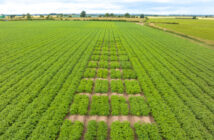Details of an ambitious programme of coordinated cover crop trials have been published by AHDB Cereals & Oilseeds.
Led by ADAS, the AHDB-funded work will quantify the longer-term effects of cover crops, as straights and mixtures, and assess the impact of cultivation, establishment and destruction techniques.
Conducted over three years, the field experiments build upon recommendations from the recently published AHDB cover crop review and capitalise on the AHDB Monitor Farm network.
Dr Amanda Bennett, who manages resource management work at AHDB, said: “Our review showed that we need to know much more about the longer-term effects of cover crops.
“Through these coordinated field experiments, we will build a much better understanding of the costs and benefits of including cover crops within a rotation.”
Cover crop selection and cultivation
Three field experiments, on contrasting soil types, will quantify the effect of ten cover crop treatments (seven straights and three mixtures), established using a standard cultivation approach, on soil properties, crop rooting and yield.
The influence of cultivation and destruction approach on cover crop success will also be determined through the use of cover crop tramline trials, conducted at three contrasting (soil type/rotation) AHDB Monitor Farm sites, in addition to a Hutchinsons’ farm site.
Tramline trials will also be established at the commercial sites to provide further information on species selection.
The impact of the cover crop approaches will be assessed through soil health measurements, including soil moisture, soil organic matter, earthworm counts, soil strength and soil nutrient content (P, K and Mg). Measures of yield and quality will also be taken on the following two cash crops.
Costs associated with seed, establishment and destruction and nitrogen fertiliser savings, will be used to develop detailed cost-benefit analysis information.
Cover crop guidance
The project findings, due in 2019, will be used to update AHDB guidance on cover crops.
It is also anticipated that the project will help steer the development of bespoke cover crop seed mixtures more able to root more deeply and extensively.
Interim findings will be promoted during the lifespan of the project, including at the three host AHDB Monitor Farms: York (David Blacker), Huntingdon (Russell McKenzie) and Sittingbourne (Mark Bowsher-Gibbs).
Project information, as well as the cover crop review, videos and case studies, can be accessed at cereals.ahdb.org.uk/covered




